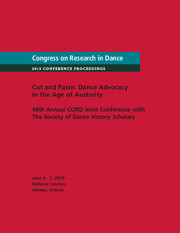Article contents
Panelist Question and Response
Published online by Cambridge University Press: 04 January 2013
Extract
Eeva Anttila (to Sue Stinson): One thing that comes to my mind is the conception/theory of learning that you currently feel most connected to. Could you clarify that? Is your conception in conflict with the learning objectives discourse that you have to deal with, and if yes, how so? Could you use some theoretical references to overcome this kind of demand that you are subjected to? For instance, constructivist learning theory is based on the idea that everyone learns different things, based on their previous experiences etc.
- Type
- Panel: Critical Issues in Pedagogy and Research: Perspectives on Dance Education Theory and Practice
- Information
- Copyright
- Copyright © The Author(s) 2009
References
Works Cited
- 1
- Cited by


